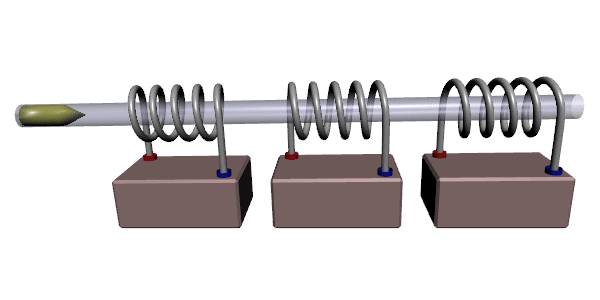Magnetism
History of magnetism
- The ancient Greeks, originally those near the city of Magnesia, and also
the early Chinese knew about strange and rare stones (possibly chunks of
iron ore struck by lightning) with the power to attract iron. A steel needle
stroked with such a "lodestone" became "magnetic" as well.
- Around the year 1000 A.D., the Chinese found that such a needle, when
freely suspended, pointed north-south. The magnetic compass soon spread to
Europe. Columbus used it when he crossed the Atlantic ocean, noting not only
that the needle deviated slightly from exact north (as indicated by the
stars) but also that the deviation changed during the voyage.
- Around 1600, William Gilbert, physician to Queen Elizabeth I of England,
proposed an explanation: the Earth itself was a giant magnet, with its
magnetic poles some distance away from its geographic poles (i.e., near the
points defining the axis about which the Earth spins).
- By convention in the United States today, the compass arrow points in
approximately the direction of the North Geographic Pole. And by convention
(unrelated to the first convention), the compass arrow is labeled a magnetic
north pole, which is attracted to (points to) the magnetic south pole of a
bar magnet, often marked with an “S” or with blue color. Using the fact that
opposite poles attract, this means that the compass arrow must be attracted
to a magnetic south pole in the Northern Hemisphere on Earth.


Magnets
- Magnets always have two poles, come in various shapes, and attract or
repel other magnets.
- There are permanent magnets, temporary magnets, and electromagnets.
- Magnetite is a magnetic material found in nature. It is a permanent
magnet, but it is relatively weak.
- Most permanent magnets we use today are manufactured and are a
combination or alloy of iron, nickel and cobalt. Rare-earth permanent
magnets are a special type of magnet that can have extreme strength.
- An example of a temporary magnet is soft iron, which retains
magnetism for a relatively short time.
- Magnets have two poles, called the north (N) and south (S) poles.
Opposite poles attract and like poles repel.
- Elements such as Iron, Cobalt, and Nickel make great permanent magnets.
Copper and Aluminum are mostly nonmagnetic.
- Magnetic domains can be induced (forced to align) by applied magnetic
fields. This is why a nail, which is normally
nonmagnetic becomes
magnetic when touched by a magnet.
Magnetic poles
- An interesting characteristic of magnets is that when you cut a magnet
into parts, each part will have both N and S poles. In other words, it is
not possible to create a magnetic monopole.
- All magnets have a North-seeking pole (N) and South-seeking pole (S). In
a compass, the side marked (N), often colored red, will point toward the
Earth's 'North' magnetic pole, the magnetic pole that lies in the geographic
North pole. However, because the north pole of the magnet is attracted to
this pole it is actually a geomagnetic south pole. The geomagnetic south
pole is not located right on top of the geographic north pole but is
actually several hundred miles away. Similarly, the geomagnetic north pole
is located a few hundred miles away from the geographic south pole.
Solenoid
- A solenoid is a simple electromagnetic device consisting of a coiled
electric wire, wrapped in the shape of a helix. When electric current is
passed through the wire, the solenoid acts like a magnet with N and S poles
at the ends of the helix.
- Since it is hollow, a solenoid can draw an ferromagnetic rod into the
helix. This effect is handy in creating switching or locking devices.
Another use of a solenoid is in the creation of an electromagnet. When an
iron rod is permanently placed inside the solenoid, the metal greatly
increases the magnetic effect.
Electromagnets
- Electromagnets are made by winding an insulated wire around an iron core
and then passing electric current through the wire. The solenoidal
('spiraling') electric current causes the atoms in the core to align along
the axis, which turns the core into a magnet.
- The direction of the current determines which end of the electromagnet
becomes the north (N) pole and which becomes the south (S) pole of the
electromagnet.
- A major feature of an electromagnet is that you can adjust the strength
and direction of the field, and turn it on and off. This allows for a number
of applications, including doorbells, loudspeakers, coil gun, and maglev
train.
- Strong electromagnets are often used in areas of heavy industry to move
large pieces of iron or steel. They are commonly employed in junkyards,
where a crane with a huge electromagnet is used to pick up, move and drop
old, junked cars.
- A simple electromagnet can be made by wrapping an insulated wire around
an iron nail and using a battery to provide the electric current.

Applications

Return to class notes TOC.
Page last modified:


